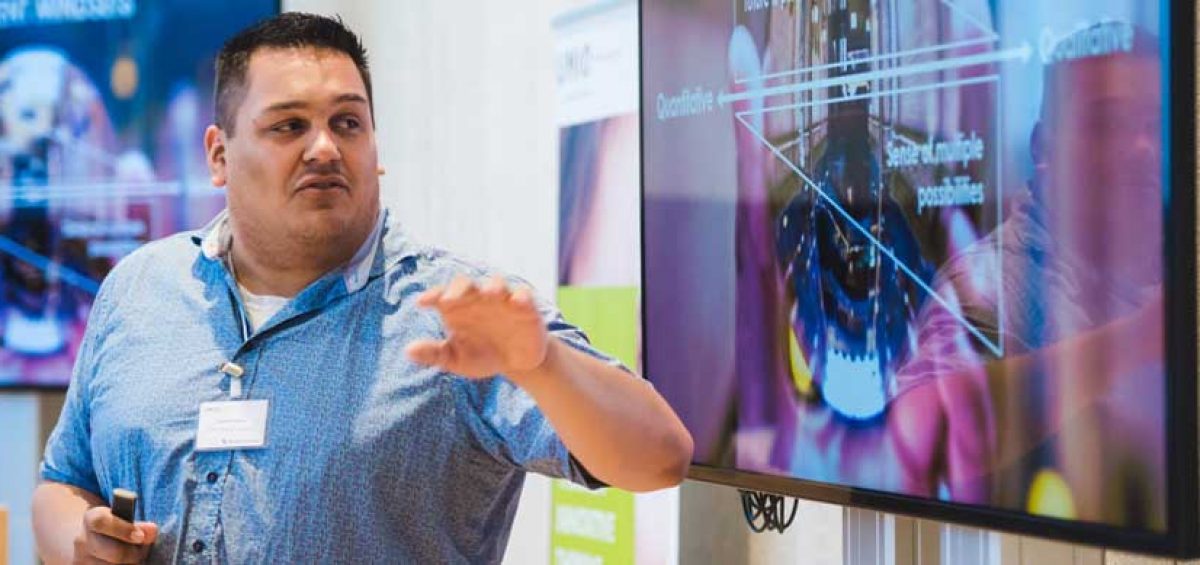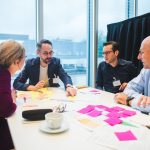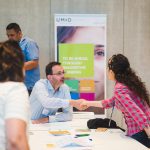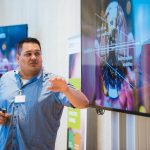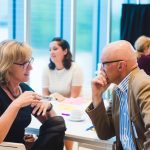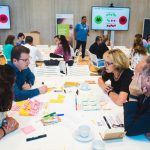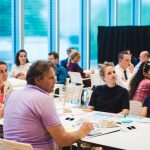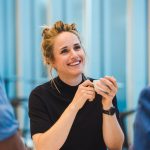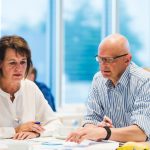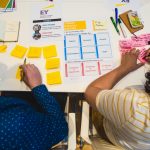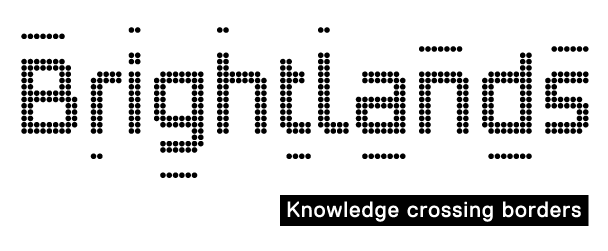Imagining possible futures through extreme scenario planning isn’t a typical day in the office. The participants attending UMIO’s Breakfast Booster on Thursday 20 June however, know that these sessions do not fall easily into the typical mould of corporate training. The event took place in (King) Arthur’s Auditorium at Brightlands Chemelot Campus, a fitting location for this particular ‘round table’, where the search for the holy grail of ‘future vision’, was the order of the day.
Service Innovator, trainer and coach, Damien Nunes from UMIO, lead the session. With a background in engineering, architecture and design, he introduced these concepts in the context of innovation within organisations. The session’s raison d’etre, was about ensuring we stay relevant in the 21st century. The interactive element of these sessions, together with creating the space to influence and build networks, is a large part of the success of these Breakfast Boosters.
Reactive predictions vs proactive visions
Traditional strategies which create future scenarios by prediction is no longer adequate. Rather than always reacting to an uncertain predicted future scenario, we need to explore the key ideas around the complexities of uncertainty and ambiguity. The crystal ball idea of looking into the future may no longer be necessary if we can change our mindset and learn how to get better at our own proactive vision.
‘If you are working on something exciting that you really care about, you don’t have to be pushed. The vision pulls you.’ Steve Jobs.
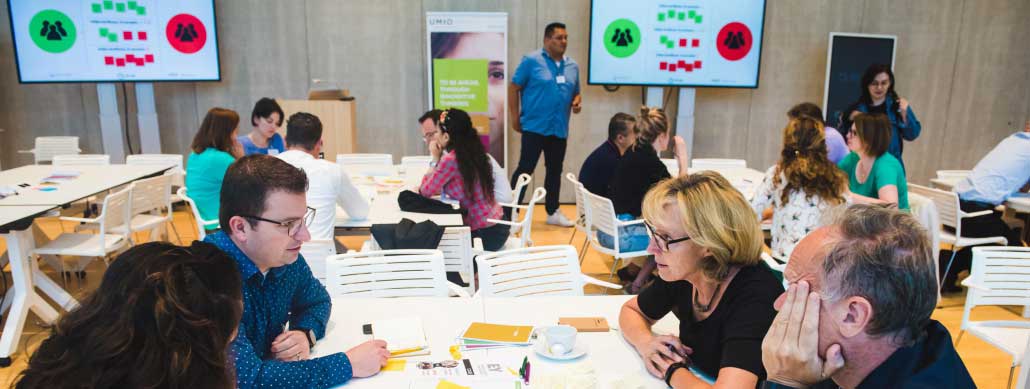
Extreme scenario mapping
Damien introduced the concept of Speculative Design which is about looking at how things could be and imagining possible futures by asking ‘what if’ questions.
‘It is a form of design that can help us to define the most desirable futures, and avoid the least desirable.’ – Anthony Dunne & Fiona Raby
This approach opens the debate and allows for discussion about the kind of future people want and don’t want. The group was tasked with some ‘agile doing’ and needed to come up with their own extreme visionary thinking using a Speculative Design approach. They were divided into smaller groups of 4 and 5 and armed with colourful post-it notes, markers and worksheets, they put into practice what they had learned.
Damien gave each group a case study outlining an extreme scenario in opposites. Half of each group then considered the scenario from that perspective. One group of 4, for example, had the Ernst and Young case study and one pair focussed on the extreme scenario of high income. This scenario outlined a future where there is an extreme shortage of digital skills, so wages rise. They had to consider what the implications of this might be in terms of politics, people, economics, new tech, environment and legislation. The other pair were focussed on the same organisation but from a ‘mincome’ scenario. This future was one where everybody gets a minimum income from the government and likewise they had to consider these scenarios.
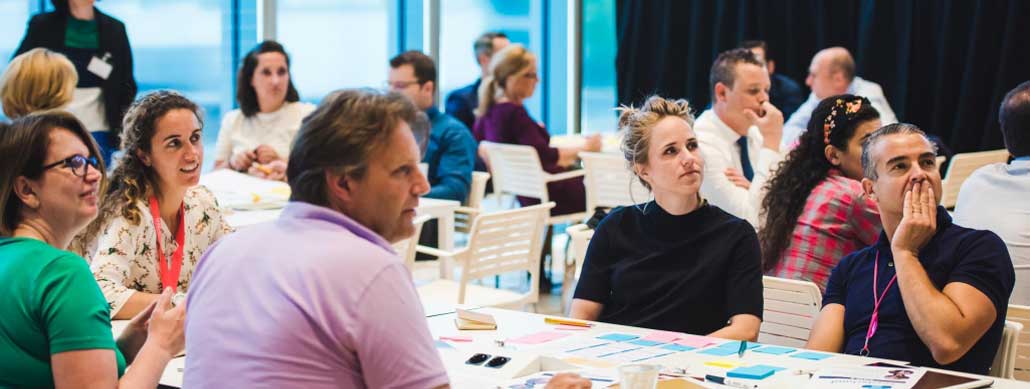
Sharing and converging
The participants worked on these scenarios individually and collectively, before sharing and mapping interventions for each one. There was a high level of engagement amongst the groups. The discussion focussed on the challenges and opportunities of what if x happened, the company would need to deal with, strive for, make use of, these different things. There was also an intrinsic need to consider other people’s perspectives and take account of a perspective that you might not necessarily agree with.
Surprising takeaways
It was interesting that although each group had opposing scenarios, the outcomes were often similar. There seemed to be more of a converging of outcomes, than a diverging. What does this tell us about our current approach to strategy and planning for the future? Perhaps we can learn to do this in a different way, a way that takes into account all the possible futures that could be. These possible futures are lenses used to better understand the present, and what we want and don’t want to see in our future as a society. (Dunne and Raby) To paraphrase designer and engineer, Buckminster Fuller, the best way to predict the future is to design it.
This thinking outside of the box, was something that Roger Heijmans, an innovator from the T2 Campus, said was one of the reasons he was there. ‘It’s not about asking the what, but the why.’ Lous Balk, Project Manager from DSM, agreed, ‘that’s the reason we’re here, we care about what happens the day after tomorrow’.
The sharing and networking opportunities in this kind of session were also key takeaways for many of the participants. Although as several members of the group admitted, they don’t like ‘networking’ in a formal capacity and yet, these sessions make it easy to feel as if this is just a gathering of interested minds. It is an informal learning opportunity, and to be welcomed with a delicious breakfast at a great location for 2 hours on a Thursday morning, what’s not to like!
Are you ready for more challenging thinking?
Then why not come along to UMIO Insights Event, on 2 July 16.00 – 19.00?
Our last chance before the summer break to meet, exchange, inspire and be inspired by professionals and academics in your field. Sign up now to reserve a place at the sessions of your choice!
For more Customer-Centric Innovation and Design Thinking, our 3-day Maastricht Summer Experience on 24-26 July is the perfect opportunity for you!
Do you want to identify business challenges and potential innovations, and make them tangible? We offer customised service innovation provision, please get in touch with us to find out how we can help your organisation stay relevant for the the day after tomorrow. Service Science Factory (SSF)

